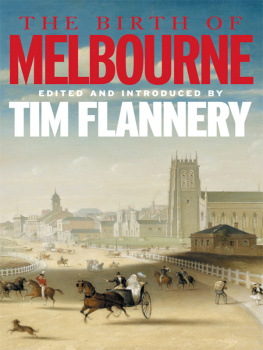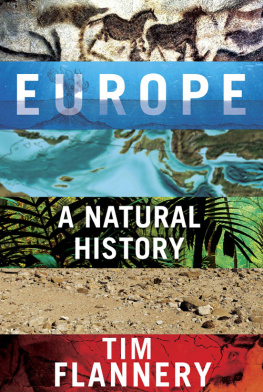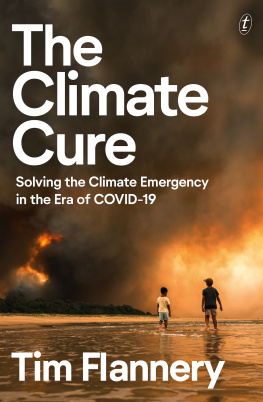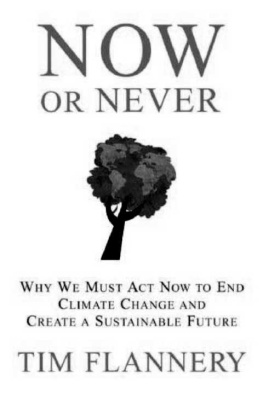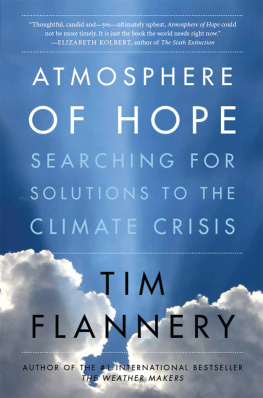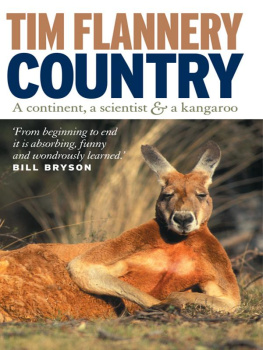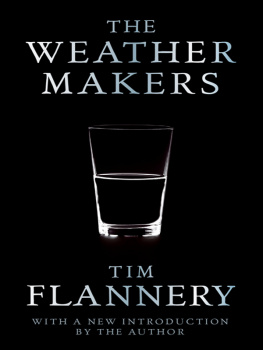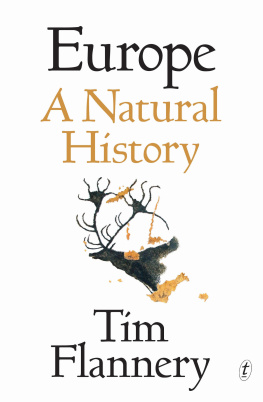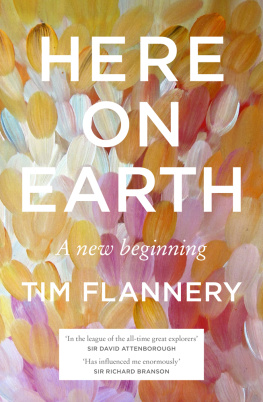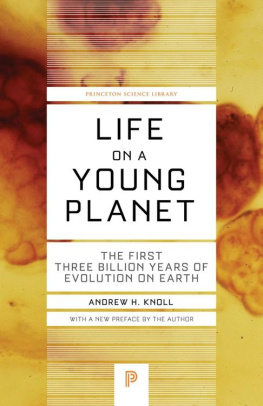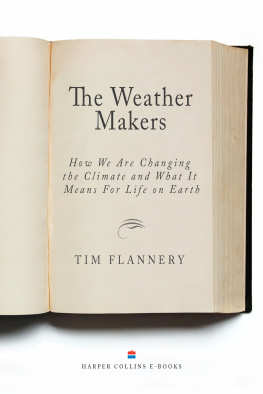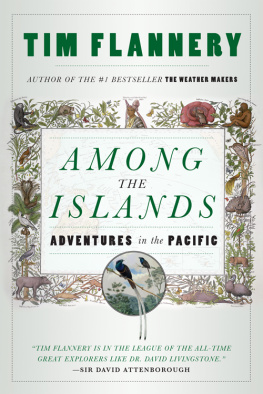Tim Flannery is a writer, a scientist and an explorer. He has published over a dozen books including the award-winning bestsellers The Future Eaters, The Eternal Frontier and The Weather Makers. The 2007 Australian of the Year, Tim is Panasonic Professor in Environmental Sustainability at Macquarie University, and is National Geographics representative in Australasia. He sits on the sustainability boards of Siemens and Tata Power and the board of WWF International, and from 2007 to 2010 he chaired the Copenhagen Climate Council. Tim lives on the Hawkesbury River in New South Wales.
HERE ON EARTH
A Natural History of the Planet
TIM FLANNERY

Copyright 2010 by Tim Flannery
All rights reserved. No part of this book may be reproduced in any form or by any electronic or mechanical means, including information storage and retrieval systems, without permission in writing from the publisher, except by a reviewer, who may quote brief passages in a review. Scanning, uploading, and electronic distribution of this book or the facilitation of such without the permission of the publisher is prohibited. Please purchase only authorized electronic editions, and do not participate in or encourage electronic piracy of copyrighted materials. Your support of the authors rights is appreciated. Any member of educational institutions wishing to photocopy part or all of the work for classroom use, or anthology, should send inquiries to Grove/Atlantic, Inc., 841 Broadway, New York, NY 10003 or permissions@groveatlantic.com .
Grateful acknowledgment is made for permission to reproduce the following illustrations: Charles Darwin: University College London. The sand walk: Ted Grant. Alfred Russel Wallace: The Wallace Fund, George Beccaloni. The island of Ternate: Tim Flannery. James Lovelock: Bruno Comby. Tim Flannery: Nick Rowley. Homo floresiensis and Elasmotherium sibiricum: Peter Schouten. Telefol elders and long-beaked echidna: Tim Flannery. Wisent: Romanowa. Pre Davids deer: Lily M. Atomic bomb cloud: United States Department of Defense. Greenland icecap: NASA. Attine ants: Arpingstone.
First published in 2010 in Australia by The Text Publishing Company, Melbourne.
Cover design by W. H. Chong
Page design by Susan Miller
Printed in the United States of America
eBook ISBN-13: 978-0-8021-9560-9
Atlantic Monthly Press
an imprint of Grove/Atlantic, Inc.
841 Broadway
New York, NY 10003
Distributed by Publishers Group West
www.groveatlantic.com
NOT FOR RESALE
To VJF, OMS and MH
Contents
Pebbles in the sand walk of perpetual worries. Darwin loses faith and discovers the monster that created us. Like confessing a murderbut of what or whom? The sagacity and morality of worms. More are born than can survive. Charles Darwin Jrs death at evolutions dawning. Understanding mired in ignorance. Which favoured races?
Yan Fu and heavens performance.
Dawkins selfish genes in a selfish world. Competition: the leitmotif of the twentieth century. A Lamarckian vision of cultural evolution.
Semons marvellous mnemes, including one that changed the atmosphere. Wards terrifying Medea. The survival of the fittest as the survival of none.
Alfred Russel Wallace: a working-class evolutionist with a social conscience. Flashes of genius. Pondering mans place in the Universe. Studies of dust. Musings on the beetle that writes. On evolution and soccer. Would a Wallacean world have been different? The sum of cooperation of all life. Venus and Mars, and Lovelocks jet-propelled understanding. Gaia, from the horses mouth. The mysteries of Daisyworld. Gaia and Lord of the Flies. Sir Francis Bacon and the great Christian morality play. A new pagan emptiness?
Great self-choreographed extravaganzas of electrochemical reaction. Earths animated crustfrom dust to dust. Elements wrought from stardust. Transubstantiation of the carbony hosts. The 100-terawatt budget that unbalances Earths organs. Life creates the continents and the atmosphere. Earth our great oyster. For the love of cadmium. The misleading salt of the Earth. Storage in stone. The abysssump or pump? The arrival of the burrowers.
The tightness of connectionsa doctors opinion. A living planet without a brain? The importance of geo-pheromones. The test of homeostasiscan Gaia control herself? The faint young Sun paradox. A Milankovitch failureor a schizoid Earth? A commonwealth of virtue. Life in a country long unchanged. How women are making men in their minds image. Why the world is full of lonely giants. Earths productivitya sort of magic pudding? May the African honeyguide frame our thinking.
What makes us different? The lying deer and the importance of the mneme. Our Medean face, and the sins of a wanderer. Why Adam and Eve never met. Why the largest, fiercest and strangest have disappeared. The tale of the toad pioneers. How Homo erectus trained the Old World giants.
Why we should call Australia home. Dont blink or youll miss the extinction. Do Neanderthals hide piecemeal within us? Conquest of the mammoth steppe. Of Pharaohs and dwarf elephants. Emptying the Americas. The unicorn and the wanderer of Baghdad. How the hobbit saved the dragon and the giant rat of Flores. Why pests come in pairs. Pleistocene weather makers?
Hunters and the challenge of the commons. Making gardens with fire. The Telefol and the long-beaked echidna. Respect for elders can protect ecosystems. Royal huntinga progenitor of modern conservation. The wisent of Bialowieza, and the swamp deer of Beijing. Almost every large creature survives by our good grace. Survival of the fittest ecosystem? Why we love lawns and water views. The heart of man and a humanist credo.
Civilisations created without the use of reason. The Pioneer and The Soul of the White Ant. Ant herders, farmers and slaves. Bodies and superorganisms. Buffons needle theorem and ant democracy. South American ants vs Elizabethan England. An amazing New World civilisation.
Monogamy and the origins of superorganisms. How polyandry pays off, and the mystery of inclusion. A species-wide brush with death preconditioning us to superorganise. The miracle at the pin factory. The collective strength of the weak. Why were becoming more stupid, but more peaceful. The loss of commonsense? The unlikely triumph of democracy. A second human influence on the atmosphere.
Empire of the idea. Five roads to civilisation. The smallest superorganism and its love of taro. Crops, towns, metals and empirespredestined steps to superorganisation? Printing, gunpowder and the compass: the value of imperfect connections. Can we see ourselves in Rome? Collapse leaving millennia of tribal war. The scientific method, industrial revolution and political reforma triumphal triad. The superglue that is American culture. Colonial success and its sequel.
The whole world as an enemy. On destroying a gram of matter. Richfield Oil Corporations atomic tar-oil. Hydrogen bombs to melt the Arctic ice. Borisovthe would-be father of the Polar Gulf Stream. A memento of atomic madness in every brain. Radiation takes the express train to the abyss.
How Nazi research led to Silent Spring. Organochlorines and organophosphates. Death chemicals passed on in mothers milk.
A Japanese beetle invades the US and is carpet-bombed with pesticides. Poisoning the salmon, too. The eagle and the banker. The toxic 1960s live on in us. Denmark and the decline of sperm. PCBs, hermaphrodites and shrivelled sex organs. Toxins silently fill the abyss. Man must conquer nature.


